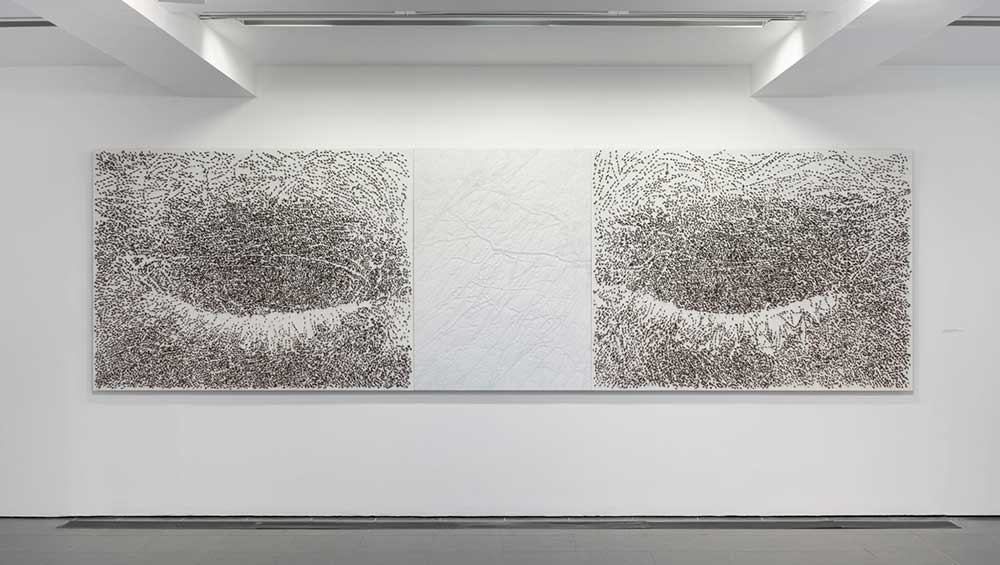
Giuseppe Penone, A occhi chiusi (With Eyes Closed), 2009. Acrylic, glass microspheres, acacia thorns on canvas, and white Carrara marble. © Photo: George Darrell. Courtesy Giuseppe Penone and Serpentine.
Serpentine South Gallery, London
3 April – 7 September 2025
by DAVID TRIGG
In Kensington Gardens in London, high above our heads, are several large boulders, finely balanced in the leafless branches of two tall trees. It is safe to assume that these hefty river stones are not going to fall, but the thought of them becoming dislodged gives these gravity-defying sculptures by the Italian artist Giuseppe Penone a threatening presence. On closer inspection, it transpires that the trees are in fact made of bronze, a revelation that brings a modicum of comfort. For Penone, these works from the series Idee di Pietra (Ideas of Stone, 2010-24), represent human thoughts or ideas that, like stones burnished by flowing water, are “polished by the passage of time, compacted by the weight of memory”. Ideas are, of course, ethereal and delicate things, but Penone reminds us that they can have very material consequences.
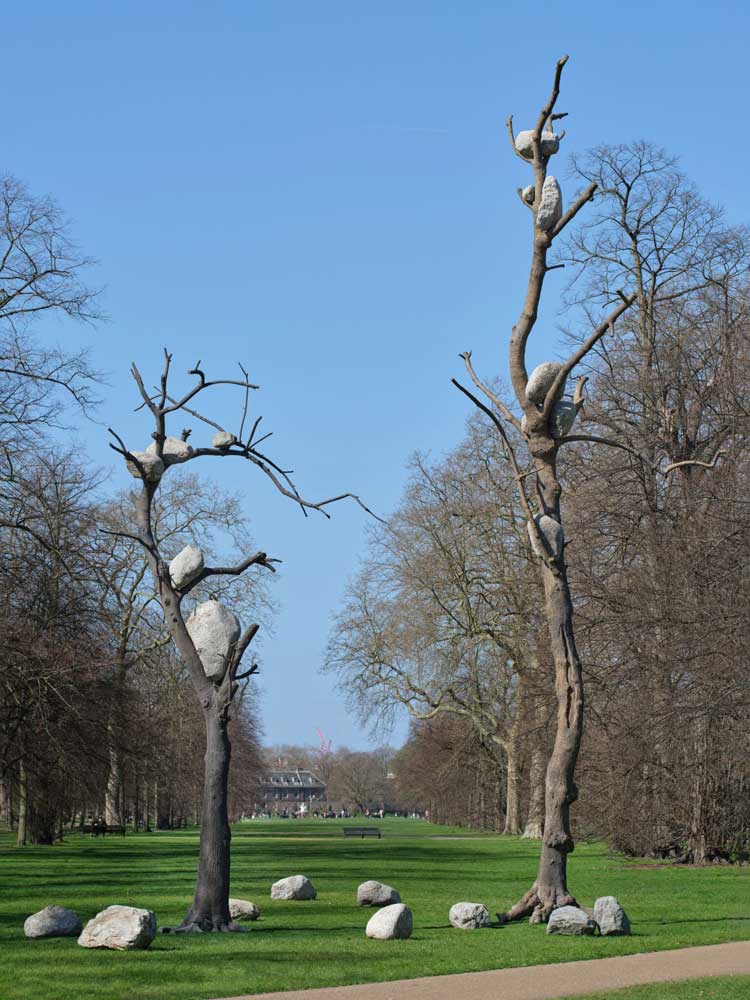
Giuseppe Penone, Idee di pietra (Ideas of Stone), 2010–24. Bronze and river stones. © Photo: George Darrell. Courtesy Giuseppe Penone and Serpentine.
Typically poetic and arresting, these outdoor works are accompanied by Albero Folgorato (Thunderstruck Tree, 2012), another cast bronze tree based of a century-old willow that had its trunk dramatically split open by a bolt of lightning. Penone has lined the sculpture’s interior with gold-leaf, bringing permanence and beauty to a destructive act of nature. Born in Piedmont, Italy in 1947, and coming to prominence as part of the arte povera generation in the late 1960s, the artist has obsessed over all things arboreal for more than five decades. His expansive oeuvre includes numerous works created with the twigs, leaves, roots, branches and majestic forms of trees, a selection of which form this focused retrospective at the Serpentine Gallery.
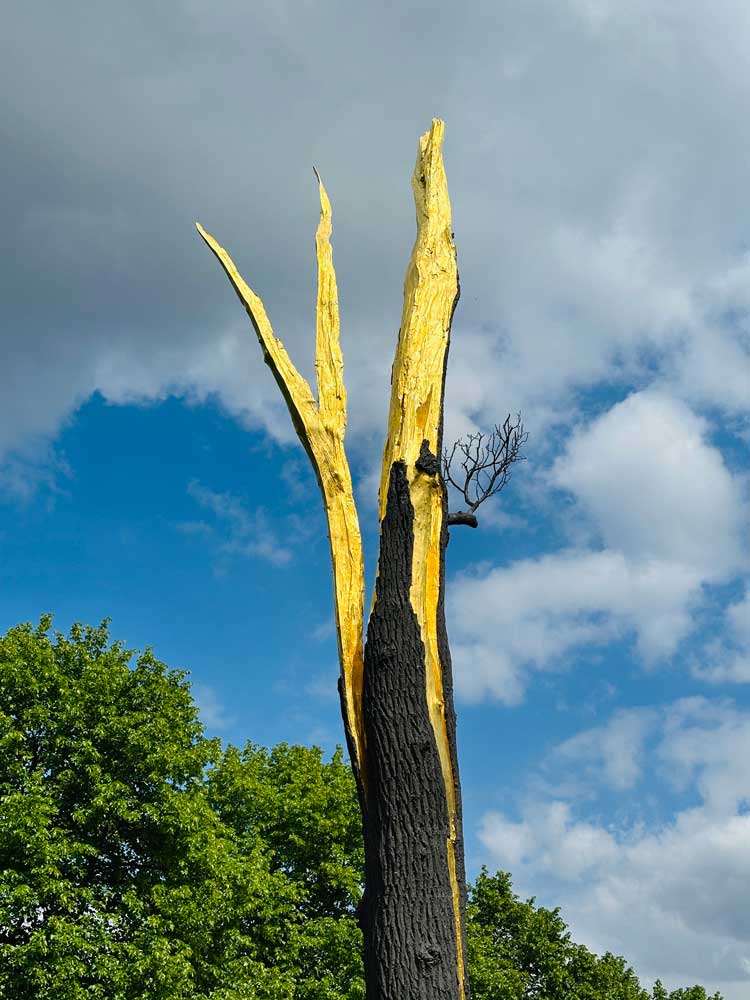
Giuseppe Penone, Albero folgorato (Thunderstruck Tree), 2012. Bronze and gold. Photo: Martin Kennedy.
The exhibition opens with A Occhi Chiusi (With Eyes Closed, 2009), in which a slab of white Carrara marble is bookended by two canvases covered with sharp acacia thorns that, from a distance, form the image of a closed pair of eyes. The interplay between sight and non-sight is an enduring theme for Penone, underscoring the emphasis on non-visual senses in his practice. An early photograph, Rovesciare i Propri Occhi (Reversing One’s Eyes, 1970), shows the artist with his eyes covered by mirrored contact lenses, depriving him of sight but reflecting back to the viewer the landscape before him. This theme is riffed on in Sguardo Vegetale (Vegetal Gaze, 1995), where a similar black-and-white self-portrait, printed on a ceramic tile, is punctured through the eyes by the fine branches of a young sapling: the artist’s gaze is literally held by a tree.
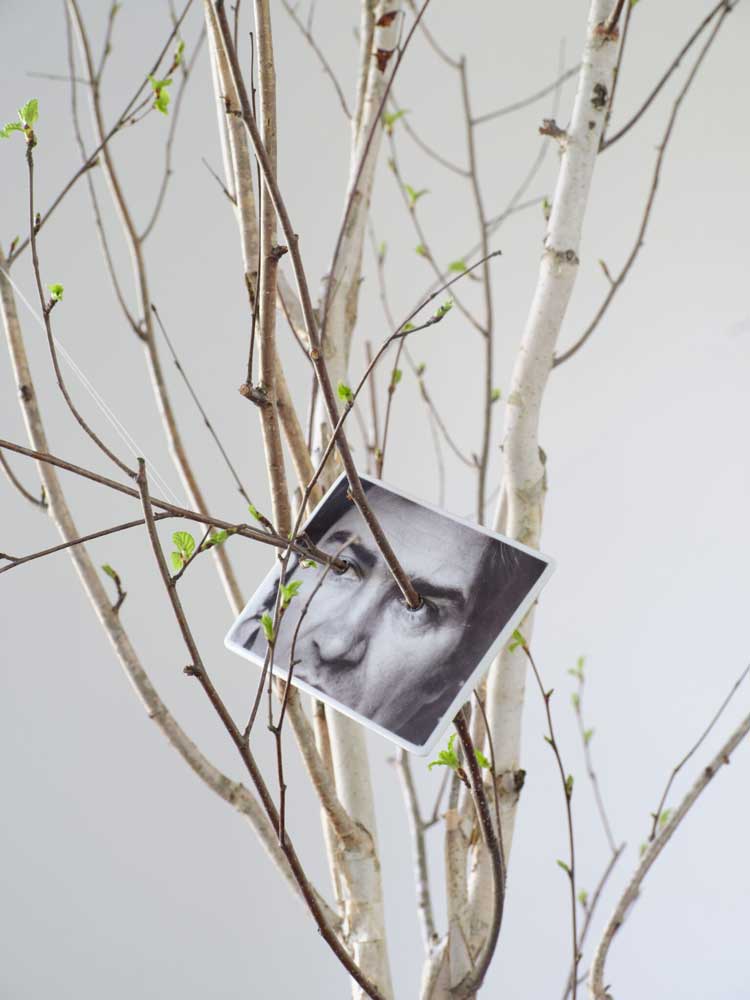
Giuseppe Penone, Sguardo vegetale (Vegetal Gaze), 1995. Photo ceramic. © Photo: George Darrell. Courtesy Giuseppe Penone and Serpentine.
Despite being billed as the most comprehensive institutional exhibition of Penone’s practice in London, and spanning more than 50 years of work, the show feels unduly modest. Moreover, apart from a handful of standout pieces, many selections are surprisingly underwhelming. The artist has made many spectacular tree-based works, on intimate as well as monumental scales, though pieces on display here, such as Gesti Vegetali (Vegetal Gestures, 1983), in which twisted and sprawling bronze figures intertwine with living pot plants, are sadly not among them. Nearby, the enormous Verde del Bosco (Forest Green 1986-ongoing) drawings reflect Penone’s lyrical approach, but these forest scenes, made by rubbing the trunks and branches of living trees with leaves and vegetal matter, reveal the limitations of his draughtsmanship.
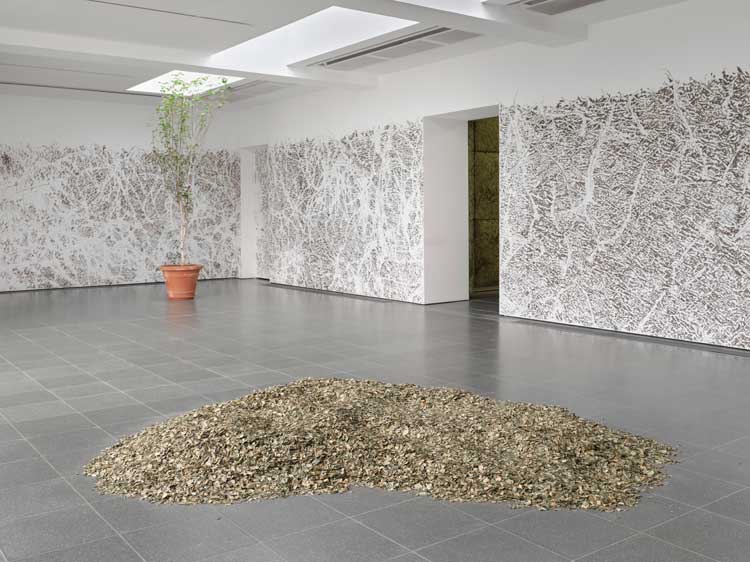
Giuseppe Penone, Thoughts in the Roots, 2025. Installation view, Serpentine South. © Photo: George Darrell. Courtesy Giuseppe Penone and Serpentine.
A classic work is Soffio di Foglie (Breath of Leaves, 1979): a pile of dried boxwood leaves on the floor on which Penone lay face down, breathing into them. According to the gallery guide “the imprint of his body and breath is left on the leaves”, yet there are barely any discernible traces of the artist’s presence here. The dead foliage is upstaged by the leafy trees of Kensington Gardens, the lush greenery of which is visible through the gallery’s windows.
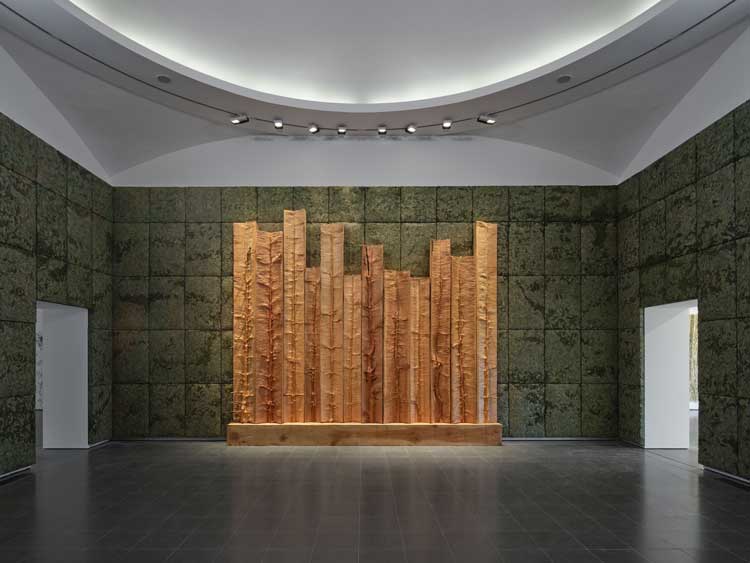
Giuseppe Penone, Alberi libro (Book Trees), 2017 and Respirare l’ombra (To Breathe the Shadow), 2000, installation view, Serpentine South. © Photo: George Darrell. Courtesy Giuseppe Penone and Serpentine.
The exhibition redeems itself magnificently in the gallery’s central space, which you smell before you see. Here, the walls are lined with hundreds of thousands of laurel leaves, packed into a grid of cage-like containers. At one end of the room is Respirare l’Ombra (To Breathe the Shadow, 2000), a clay life-mask of Penone skewered through its mouth by a bronze branch. At the other, is Alberi Libro (Book Trees, 2017), for which Penone has painstakingly carved 12 tree trunks, slowly removing their rings of mature timber to form slender sculpted saplings in each one. It is as if the artist has found a time machine and taken us back to a previous stage in the lives of these trees. Yet, unlike the verdant parkland outside the gallery, there is no life in these saplings.
That this remarkable work appears like an altar piece in the hushed, subduedly lit, chapel-like space, seems apt. After all, Christ’s cross was made from wood, and Saint Peter declared that the Saviour was crucified on a tree. Even though Penone is a secular artist, it is hard not to see this work in spiritual terms, as a meditation on the cycle of life and death. “Italy is a Catholic country, and even if you’re not a believer, you’re influenced by the iconography of religion,” he has said. To unburden one’s ideas from the weight of memory, it seems, is harder than you think.